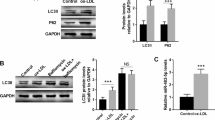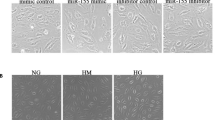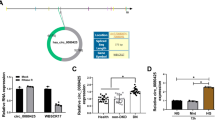Abstract
Cardiovascular disease (CVD) serves as the major cause of mortality in chronic kidney disease (CKD) patients. The injury of endothelium associated with the long-term challenge of uremic toxins including the toxic indoxyl sulfate (IS) is one of key pathological factors leading to CVD. However, the mechanisms of uremic toxins, especially the IS, resulting in endothelial injury, remain unclear. miR-214 was reported to contribute to the pathogenesis of cardiovascular diseases, while its role in IS-induced endothelial cell apoptosis is unknown. In this study, we investigated the role of microRNA-214 (miR-214) in IS-induced endothelial cell apoptosis and the underlying mechanisms using mouse aortic endothelial cells (MAECs). Following IS treatment, miR-214 was significantly downregulated in MAECs in line with enhanced cell apoptosis. Meanwhile, COX-2 was upregulated at both mRNA and protein levels along with increased secretion of PGE2 in medium. To define the role of miR-214 in IS-induced endothelial cell apoptosis, we modulated miR-214 level in MAECs and found that overexpression of miR-214 markedly attenuated endothelial cell apoptosis, while antagonism of miR-214 deteriorated cell death after IS challenge. Further analyses confirmed that COX-2 is a target gene of miR-214, and the inhibition of COX-2 by a specific COX-2 inhibitor NS-398 strikingly attenuated IS-induced endothelial cell apoptosis along with a significant blockade of PGE2 secretion. In conclusion, this study demonstrated an important role of miR-214 in protecting against endothelial cell damage induced by IS possibly by direct downregulation of COX-2/PGE2 axis.







Similar content being viewed by others
References
Culleton BF, Larson MG, Wilson PW, Evans JC, Parfrey PS, Levy D (1999) Cardiovascular disease and mortality in a community-based cohort with mild renal insufficiency. Kidney Int 56(6):2214–2219. https://doi.org/10.1046/j.1523-1755.1999.00773.x
Ross R (1999) Atherosclerosis—an inflammatory disease. N Engl J Med 340(2):115–126. https://doi.org/10.1056/NEJM199901143400207
Brunet P, Gondouin B, Duval-Sabatier A, Dou L, Cerini C, Dignat-George F, Jourde-Chiche N, Argiles A, Burtey S (2011) Does uremia cause vascular dysfunction? Kidney Blood Press Res 34(4):284–290. https://doi.org/10.1159/000327131
Goligorsky MS, Yasuda K, Ratliff B (2010) Dysfunctional endothelial progenitor cells in chronic kidney disease. J Am Soc Nephrol 21(6):911–919. https://doi.org/10.1681/ASN.2009111119
Zhu J, Yang K, Jing Y, Du R, Zhu Z, Lu L, Zhang R (2012) The effects of low-dose nepsilon-(carboxymethyl)lysine (CML) and nepsilon-(carboxyethyl)lysine (CEL), two main glycation free adducts considered as potential uremic toxins, on endothelial progenitor cell function. Cardiovasc Diabetol 11:90. https://doi.org/10.1186/1475-2840-11-90
Yang K, Nie L, Huang Y, Zhang J, Xiao T, Guan X, Zhao J (2012) Amelioration of uremic toxin indoxyl sulfate-induced endothelial cell dysfunction by Klotho protein. Toxicol Lett 215(2):77–83. https://doi.org/10.1016/j.toxlet.2012.10.004
Oberg BP, McMenamin E, Lucas FL, McMonagle E, Morrow J, Ikizler TA, Himmelfarb J (2004) Increased prevalence of oxidant stress and inflammation in patients with moderate to severe chronic kidney disease. Kidney Int 65(3):1009–1016. https://doi.org/10.1111/j.1523-1755.2004.00465.x
Watanabe H, Miyamoto Y, Otagiri M, Maruyama T (2011) Update on the pharmacokinetics and redox properties of protein-bound uremic toxins. J Pharm Sci 100(9):3682–3695. https://doi.org/10.1002/jps.22592
Vanholder R, Baurmeister U, Brunet P, Cohen G, Glorieux G, Jankowski J (2008) A bench to bedside view of uremic toxins. J Am Soc Nephrol 19(5):863–870. https://doi.org/10.1681/ASN.2007121377
Wu IW, Hsu KH, Lee CC, Sun CY, Hsu HJ, Tsai CJ, Tzen CY, Wang YC, Lin CY, Wu MS (2011) p-Cresyl sulphate and indoxyl sulphate predict progression of chronic kidney disease. Nephrol Dial Transplant 26(3):938–947. https://doi.org/10.1093/ndt/gfq580
Chiu CA, Lu LF, Yu TH, Hung WC, Chung FM, Tsai IT, Yang CY, Hsu CC, Lu YC, Wang CP, Lee YJ (2010) Increased levels of total P-Cresylsulphate and indoxyl sulphate are associated with coronary artery disease in patients with diabetic nephropathy. Rev Diabet Stud 7(4):275–284. https://doi.org/10.1900/RDS.2010.7.275
Taki K, Tsuruta Y, Niwa T (2007) Indoxyl sulfate and atherosclerotic risk factors in hemodialysis patients. Am J Nephrol 27(1):30–35. https://doi.org/10.1159/000098542
Atoh K, Itoh H, Haneda M (2009) Serum indoxyl sulfate levels in patients with diabetic nephropathy: relation to renal function. Diabetes Res Clin Pract 83(2):220–226. https://doi.org/10.1016/j.diabres.2008.09.053
Carmona A, Guerrero F, Buendia P, Obrero T, Aljama P, Carracedo J (2017) Microvesicles derived from indoxyl sulfate treated endothelial cells induce endothelial progenitor cells dysfunction. Front Physiol 8:666. https://doi.org/10.3389/fphys.2017.00666
Namikoshi T, Tomita N, Satoh M, Sakuta T, Kuwabara A, Kobayashi S, Higuchi Y, Nishijima F, Kashihara N (2009) Oral adsorbent AST-120 ameliorates endothelial dysfunction independent of renal function in rats with subtotal nephrectomy. Hypertens Res 32(3):194–200. https://doi.org/10.1038/hr.2008.29
Bartel DP (2004) MicroRNAs: genomics, biogenesis, mechanism, and function. Cell 116(2):281–297. https://doi.org/10.1016/s0092-8674(04)00045-5
Li K, Ching D, Luk FS, Raffai RL (2015) Apolipoprotein E enhances microRNA-146a in monocytes and macrophages to suppress nuclear factor-kappaB-driven inflammation and atherosclerosis. Circ Res 117(1):e1–e11. https://doi.org/10.1161/CIRCRESAHA.117.305844
Sun Y, Kuek V, Liu Y, Tickner J, Yuan Y, Chen L, Zeng Z, Shao M, He W, Xu J (2018) MiR-214 is an important regulator of the musculoskeletal metabolism and disease. J Cell Physiol 234(1):231–245. https://doi.org/10.1002/jcp.26856
Park KM, Teoh JP, Wang Y, Broskova Z, Bayoumi AS, Tang Y, Su H, Weintraub NL, Kim IM (2016) Carvedilol-responsive microRNAs, miR-199a-3p and -214 protect cardiomyocytes from simulated ischemia-reperfusion injury. Am J Physiol Heart Circ Physiol 311(2):H371–383. https://doi.org/10.1152/ajpheart.00807.2015
Chan LS, Yue PY, Mak NK, Wong RN (2009) Role of microRNA-214 in ginsenoside-Rg1-induced angiogenesis. Eur J Pharm Sci 38(4):370–377. https://doi.org/10.1016/j.ejps.2009.08.008
Eguchi S, Takefuji M, Sakaguchi T, Ishihama S, Mori Y, Tsuda T, Takikawa T, Yoshida T, Ohashi K, Shimizu Y, Hayashida R, Kondo K, Bando YK, Ouchi N, Murohara T (2019) Cardiomyocytes capture stem cell-derived, anti-apoptotic microRNA-214 via clathrin-mediated endocytosis in acute myocardial infarction. J Biol Chem 294(31):11665–11674. https://doi.org/10.1074/jbc.RA119.007537
Aurora AB, Mahmoud AI, Luo X, Johnson BA, van Rooij E, Matsuzaki S, Humphries KM, Hill JA, Bassel-Duby R, Sadek HA, Olson EN (2012) MicroRNA-214 protects the mouse heart from ischemic injury by controlling Ca(2)(+) overload and cell death. J Clin Investig 122(4):1222–1232. https://doi.org/10.1172/JCI59327
Wang X, Ha T, Hu Y, Lu C, Liu L, Zhang X, Kao R, Kalbfleisch J, Williams D, Li C (2016) MicroRNA-214 protects against hypoxia/reoxygenation induced cell damage and myocardial ischemia/reperfusion injury via suppression of PTEN and Bim1 expression. Oncotarget 7(52):86926–86936. https://doi.org/10.18632/oncotarget.13494
Duan Q, Yang L, Gong W, Chaugai S, Wang F, Chen C, Wang P, Zou MH, Wang DW (2015) MicroRNA-214 is upregulated in heart failure patients and suppresses XBP1-mediated endothelial cells angiogenesis. J Cell Physiol 230(8):1964–1973. https://doi.org/10.1002/jcp.24942
van Balkom BW, de Jong OG, Smits M, Brummelman J, den Ouden K, de Bree PM, van Eijndhoven MA, Pegtel DM, Stoorvogel W, Wurdinger T, Verhaar MC (2013) Endothelial cells require miR-214 to secrete exosomes that suppress senescence and induce angiogenesis in human and mouse endothelial cells. Blood 121(19):3997–4006. https://doi.org/10.1182/blood-2013-02-478925
Williams KC, Renthal NE, Gerard RD, Mendelson CR (2012) The microRNA (miR)-199a/214 cluster mediates opposing effects of progesterone and estrogen on uterine contractility during pregnancy and labor. Mol Endocrinol 26(11):1857–1867. https://doi.org/10.1210/me.2012-1199
Futaki N, Takahashi S, Yokoyama M, Arai I, Higuchi S, Otomo S (1994) NS-398, a new anti-inflammatory agent, selectively inhibits prostaglandin G/H synthase/cyclooxygenase (COX-2) activity in vitro. Prostaglandins 47(1):55–59. https://doi.org/10.1016/0090-6980(94)90074-4
Li S, Cheng S, Sun Z, Mungun HK, Gong W, Yu J, Xia W, Zhang Y, Huang S, Zhang A, Jia Z (2016) Indoxyl sulfate induces mesangial cell proliferation via the induction of COX-2. Mediat Inflamm 2016:5802973. https://doi.org/10.1155/2016/5802973
Steinert D, Kuper C, Bartels H, Beck FX, Neuhofer W (2009) PGE2 potentiates tonicity-induced COX-2 expression in renal medullary cells in a positive feedback loop involving EP2-cAMP-PKA signaling. Am J Physiol Cell Physiol 296(1):C75–87. https://doi.org/10.1152/ajpcell.00024.2008
Faour WH, Gomi K, Kennedy CR (2008) PGE(2) induces COX-2 expression in podocytes via the EP(4) receptor through a PKA-independent mechanism. Cell Signal 20(11):2156–2164. https://doi.org/10.1016/j.cellsig.2008.08.007
Wheeler DC (1996) Cardiovascular disease in patients with chronic renal failure. Lancet 348(9043):1673–1674. https://doi.org/10.1016/S0140-6736(05)65816-3
Feletou M, Vanhoutte PM (2006) Endothelial dysfunction: a multifaceted disorder (The Wiggers Award Lecture). Am J Physiol Heart Circ Physiol 291(3):H985–1002. https://doi.org/10.1152/ajpheart.00292.2006
Herzog CA, Asinger RW, Berger AK, Charytan DM, Diez J, Hart RG, Eckardt KU, Kasiske BL, McCullough PA, Passman RS, DeLoach SS, Pun PH, Ritz E (2011) Cardiovascular disease in chronic kidney disease: a clinical update from Kidney Disease: Improving Global Outcomes (KDIGO). Kidney Int 80(6):572–586. https://doi.org/10.1038/ki.2011.223
Ross R (1993) The pathogenesis of atherosclerosis: a perspective for the 1990s. Nature 362(6423):801–809. https://doi.org/10.1038/362801a0
Garcia-Jerez A, Luengo A, Carracedo J, Ramirez-Chamond R, Rodriguez-Puyol D, Rodriguez-Puyol M, Calleros L (2015) Effect of uraemia on endothelial cell damage is mediated by the integrin linked kinase pathway. J Physiol 593(3):601–618. https://doi.org/10.1113/jphysiol.2014.283887(discussion 618)
Lu Z, Lu F, Zheng Y, Zeng Y, Zou C, Liu X (2016) Grape seed proanthocyanidin extract protects human umbilical vein endothelial cells from indoxyl sulfate-induced injury via ameliorating mitochondrial dysfunction. Ren Fail 38(1):100–108. https://doi.org/10.3109/0886022X.2015.1104609
Sharma T, Hamilton R, Mandal CC (2015) miR-214: a potential biomarker and therapeutic for different cancers. Future Oncol 11(2):349–363. https://doi.org/10.2217/fon.14.193
Zhao Y, Ponnusamy M, Zhang L, Zhang Y, Liu C, Yu W, Wang K, Li P (2017) The role of miR-214 in cardiovascular diseases. Eur J Pharmacol 816:138–145. https://doi.org/10.1016/j.ejphar.2017.08.009
Cheng Y, Wang M, Yu Y, Lawson J, Funk CD, Fitzgerald GA (2006) Cyclooxygenases, microsomal prostaglandin E synthase-1, and cardiovascular function. J Clin Investig 116(5):1391–1399. https://doi.org/10.1172/JCI27540
Wang H, Zhang R, Zhu Y, Teng T, Cheng Y, Chowdhury A, Lu J, Jia Z, Song J, Yin X, Sun Y (2019) Microsomal prostaglandin E synthase 2 deficiency is resistant to acetaminophen-induced liver injury. Arch Toxicol 93(10):2863–2878. https://doi.org/10.1007/s00204-019-02543-1
Yu Y, Liu Q, Guo S, Zhang Q, Tang J, Liu G, Kong D, Li J, Yan S, Wang R, Wang P, Su X, Yu Y (2017) 2, 3, 7, 8-Tetrachlorodibenzo-p-dioxin promotes endothelial cell apoptosis through activation of EP3/p38MAPK/Bcl-2 pathway. J Cell Mol Med 21(12):3540–3551. https://doi.org/10.1111/jcmm.13265
Sheu ML, Ho FM, Yang RS, Chao KF, Lin WW, Lin-Shiau SY, Liu SH (2005) High glucose induces human endothelial cell apoptosis through a phosphoinositide 3-kinase-regulated cyclooxygenase-2 pathway. Arterioscler Thromb Vasc Biol 25(3):539–545. https://doi.org/10.1161/01.ATV.0000155462.24263.e4
Lan KC, Chiu CY, Kao CW, Huang KH, Wang CC, Huang KT, Tsai KS, Sheu ML, Liu SH (2015) Advanced glycation end-products induce apoptosis in pancreatic islet endothelial cells via NF-kappaB-activated cyclooxygenase-2/prostaglandin E2 up-regulation. PLoS ONE 10(4):e0124418. https://doi.org/10.1371/journal.pone.0124418
Yin J, Xia W, Li Y, Guo C, Zhang Y, Huang S, Jia Z, Zhang A (2017) COX-2 mediates PM2.5-induced apoptosis and inflammation in vascular endothelial cells. Am J Transl Res 9(9):3967–3976
Funding
This work was supported by Grants from the National Natural Science Foundation of China (Nos. 81770740, 81400750, 81670647, 81600557, 81530023, 81570643, 81873599, and 81570616), the National Key Research and Development Program (No. 2016YFC0906103), the Natural Science Foundation of Jiangsu Province (No. BK20130077), and Nanjing City Key Medical Research Project (Nos. ZKX16057, ZKX16059, ZKX18039).
Author information
Authors and Affiliations
Corresponding authors
Ethics declarations
Conflict of interest
None.
Additional information
Publisher's Note
Springer Nature remains neutral with regard to jurisdictional claims in published maps and institutional affiliations.
Rights and permissions
About this article
Cite this article
Li, S., Xie, Y., Yang, B. et al. MicroRNA-214 targets COX-2 to antagonize indoxyl sulfate (IS)-induced endothelial cell apoptosis. Apoptosis 25, 92–104 (2020). https://doi.org/10.1007/s10495-019-01582-4
Published:
Issue Date:
DOI: https://doi.org/10.1007/s10495-019-01582-4




